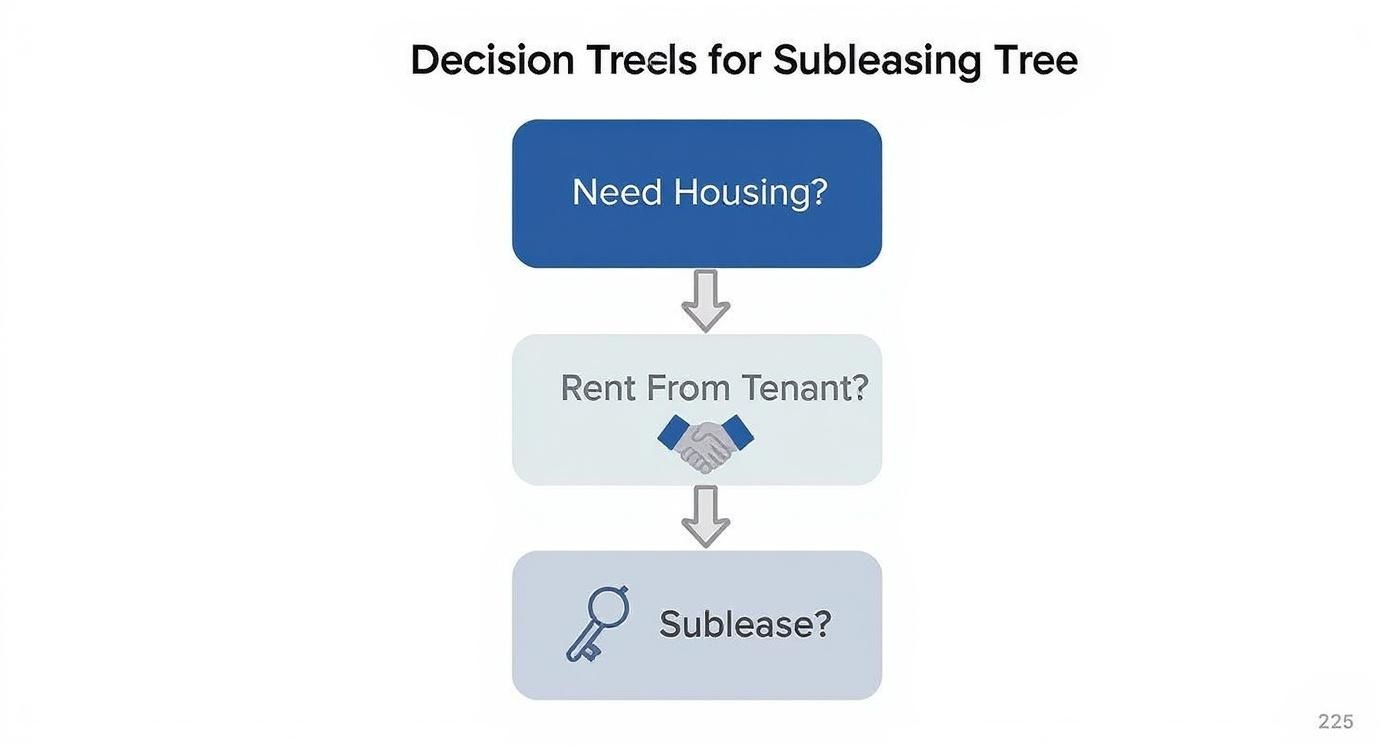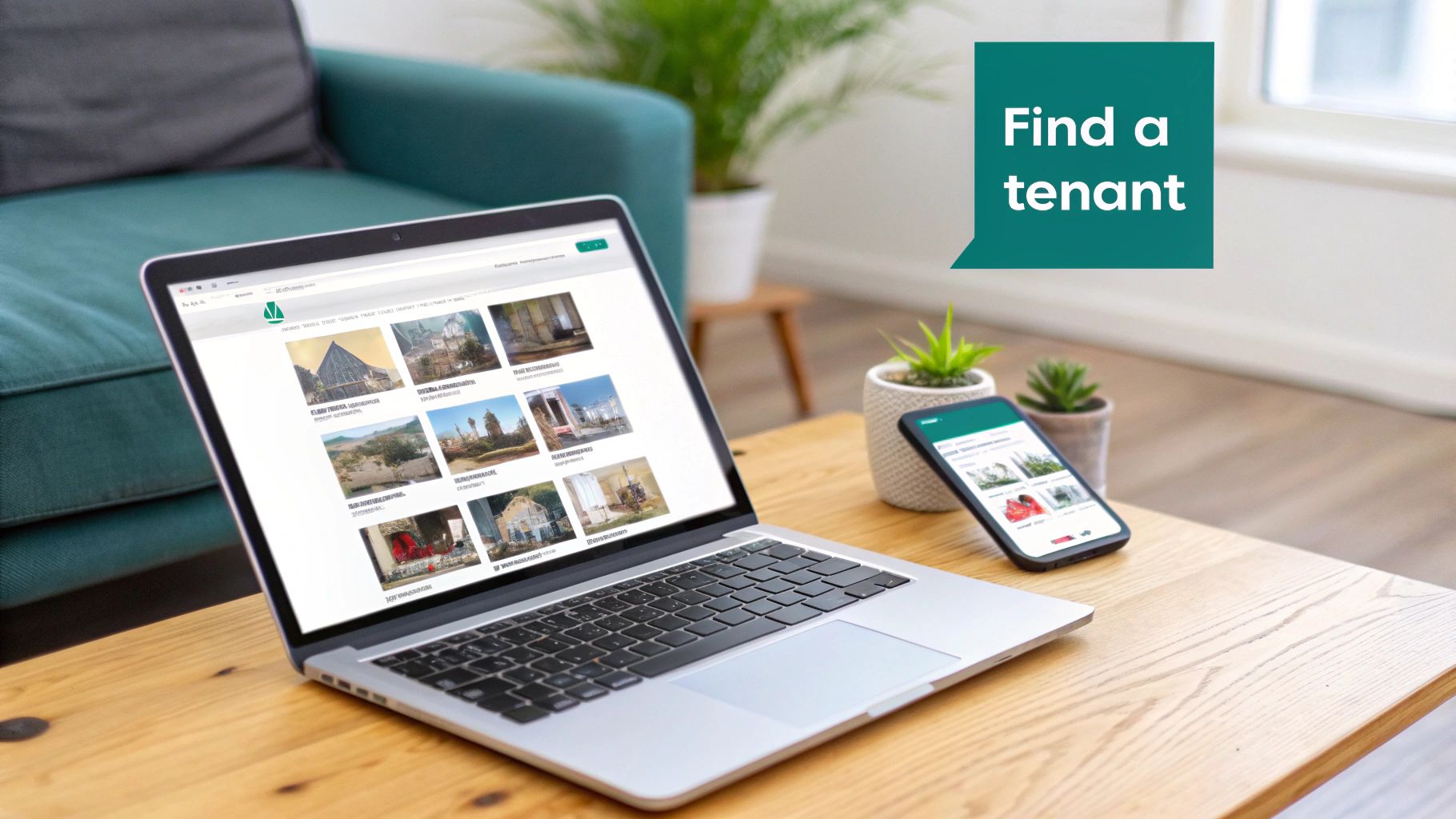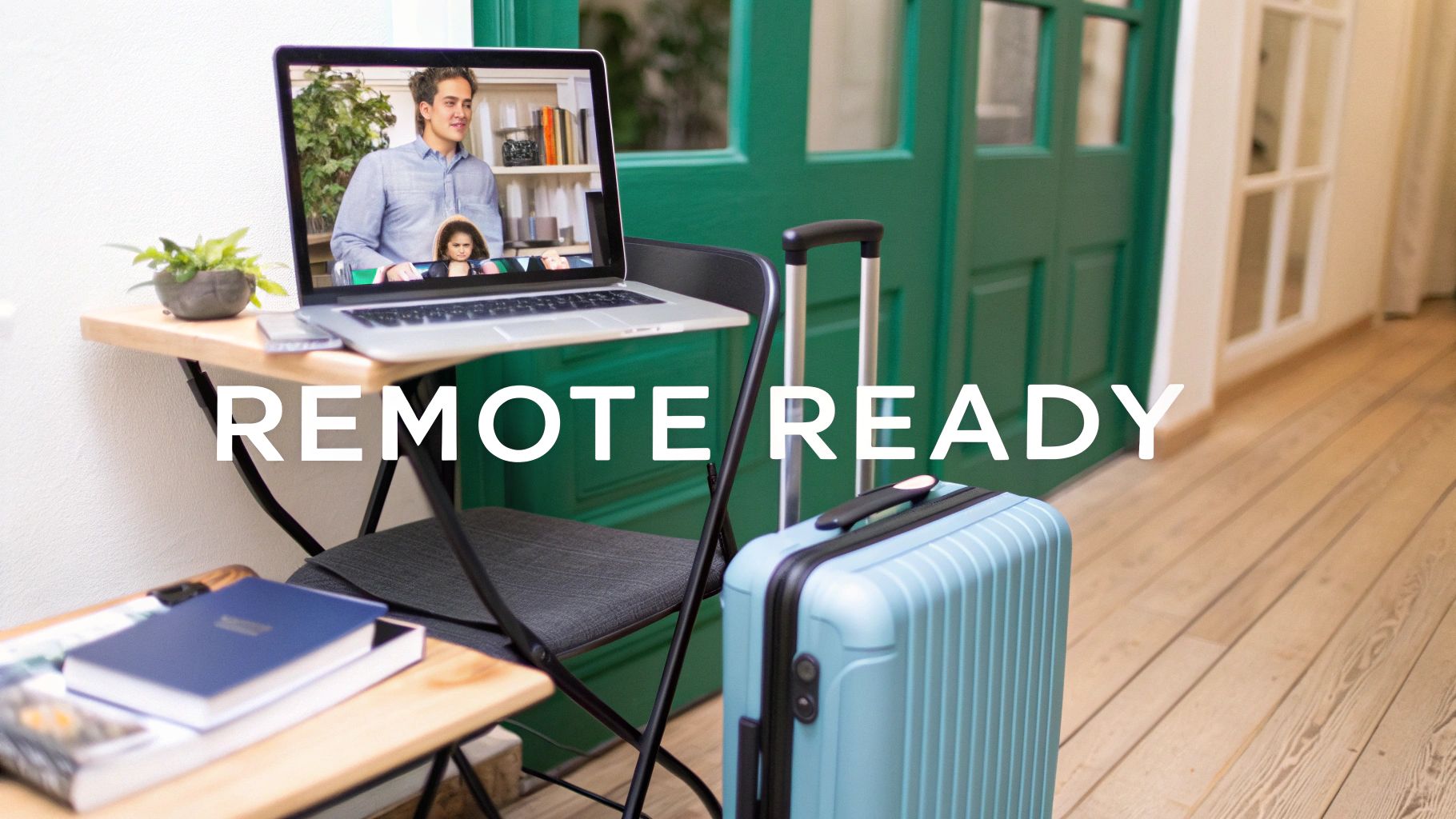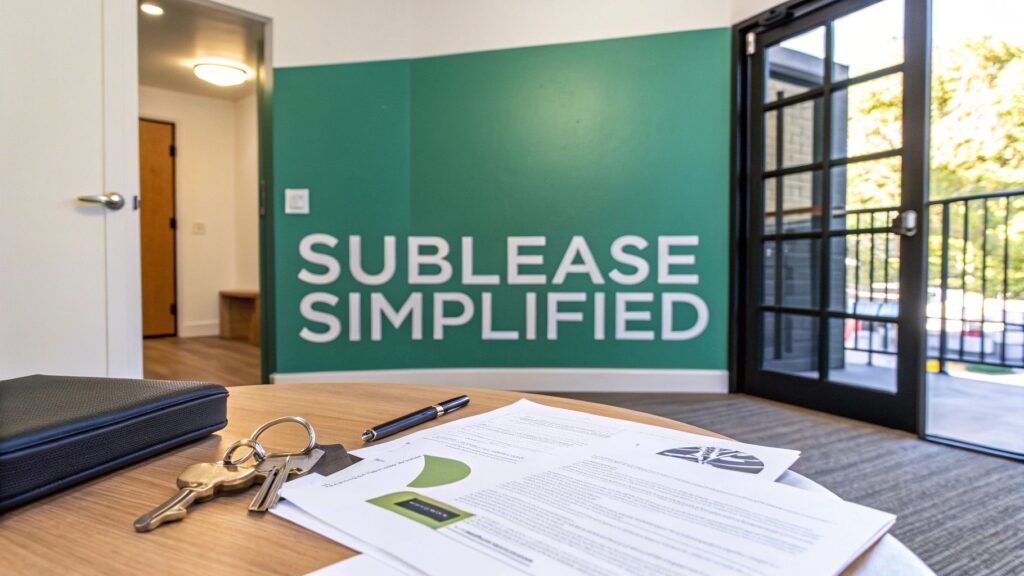Thinking about subleasing your place in Boca? It's a pretty common move, especially for students heading home for the summer or professionals on a temporary assignment. Essentially, you're renting out your apartment to someone else for a chunk of your lease term.
This lets you cover your rent while you're away, so you don't have to go through the hassle and expense of breaking your lease.
Understanding the Subleasing Basics
Picture it this way: when you sublease, you’re basically becoming a landlord for your own apartment. You still have your original lease with the property owner, but you're bringing in a new person to take over the space—and the rent payments—for a set amount of time. This adds a new layer to the whole rental situation.
To make sure everything goes off without a hitch, it's really important to know who's who in this arrangement. There are three main people involved, and each one has a specific role to play.
The People Involved
- The Sublessor: That's you, the original tenant. Your signature is on the main lease with the landlord. This is a big deal because, at the end of the day, you're still on the hook for the rent and any damages, even with someone else living there.
- The Sublessee (or Subtenant): This is the person who moves in. They’ll sign a separate sublease agreement directly with you (the sublessor), not the landlord. They'll also typically pay their rent to you.
- The Landlord/Property Owner: This is the owner of your building or your property manager. In almost every case, you absolutely need their written permission to make the sublease official and legal. Don't skip this step!
In a nutshell, subleasing is all about temporarily passing on your rental duties to someone else. But remember, your original lease doesn't just disappear—it's still your legal responsibility until it expires. That’s why a solid agreement and a trustworthy subtenant are so critical.
To break it down even further, here’s a quick look at everyone's role.
Key Roles in a Sublease Agreement
| Role | Who They Are | Primary Responsibility |
|---|---|---|
| Sublessor | The original tenant (you) | Remains responsible to the landlord for the original lease terms, including rent and property condition. |
| Sublessee | The new, temporary tenant | Pays rent to the sublessor and follows the terms of the sublease agreement and original lease. |
| Landlord | The property owner or manager | Must provide consent for the sublease and holds the original tenant accountable for the lease. |
Understanding these roles is the first step to a successful subleasing experience. It ensures everyone is on the same page and knows what they're responsible for.
Understanding the Legal Rules of Subleasing
Jumping into a sublease without knowing the rules is a recipe for disaster. This isn't just a casual arrangement; it's a formal agreement with real legal weight. Getting it wrong can lead to serious headaches, including potential eviction for both you and the person you're subletting to.
The very first place to look is your original lease agreement. Most leases will have a clause that spells out the rules on subleasing. Some ban it outright, while others permit it but only with the landlord's green light. If your lease says nothing at all, you still need to get your landlord’s permission.
Get Your Landlord's Written Consent
A quick chat and a verbal "sure, go ahead" won't cut it. You absolutely need written permission from your landlord or property manager before moving forward. Think of this document as your shield—it’s concrete proof that you followed the rules and will protect you from any disputes later on. Skipping this step is easily the biggest mistake you can make.
If you're a bit fuzzy on what your rental contract says, it’s always smart to brush up on what goes into a standard lease agreement. Understanding the framework of your own lease helps you know your rights and responsibilities inside and out.
This decision tree breaks down the basic path to setting up a sublease.

As the visual shows, subleasing is a great option for renters who need a place but are renting from another tenant instead of the property owner directly.
Draft a Bulletproof Sublease Agreement
Once you have your landlord’s blessing, your next job is to create a formal sublease agreement. This is a separate, legally binding contract between you (now the sublessor) and your tenant (the sublessee). This should never, ever be a handshake deal.
A strong sublease agreement is your primary legal protection. It transforms assumptions into clear, enforceable terms, protecting both you and your subtenant from potential disagreements down the line.
Your agreement needs to spell out all the key terms to avoid any confusion. Make sure it includes:
- Rent Details: The exact dollar amount due each month and the specific date it's due.
- Lease Duration: The precise start and end dates for the sublease term.
- Security Deposit: The amount you're collecting and the conditions for getting it back in full.
- Utility Payments: A clear breakdown of who is responsible for electricity, water, internet, and any other monthly services.
- Building Rules: A clause stating that the subtenant must follow all the same community rules outlined in your original lease.
Weighing the Pros and Cons of Subleasing Your Apartment
Thinking about subleasing? It can seem like the perfect answer when your plans change, but it’s a two-sided coin. Before you jump in, it's smart to look at both the opportunities and the potential pitfalls.
For the Original Tenant (The Sublessor)
The biggest win for the person subleasing their apartment—the sublessor—is avoiding a financial black hole. If you land a summer internship in another city or have to relocate for a few months, finding a subtenant means you're not paying rent on an empty apartment. This is almost always a better deal than paying the steep penalties that come with breaking a lease.
But with that financial relief comes a whole lot of responsibility. You’re not just handing over the keys and walking away.
The most critical thing to remember is that you are still 100% responsible for the apartment. If your subtenant skips a rent payment or causes damage, the landlord is coming to you for the money.
This is why you absolutely must screen potential subtenants carefully and always collect a security deposit. It’s your safety net.
For the New Tenant (The Sublessee)
So, what's in it for the person moving in? For the sublessee, it’s all about flexibility. You get a place to live without being locked into a standard 12-month lease. This is perfect for students home for the summer, people testing out a new city, or anyone who needs a temporary home base. Plus, these places often come furnished and at a pretty good price.
The flip side of that flexibility is a lack of security. You’re essentially renting from another tenant, not a property manager, which can sometimes make communication tricky. Your housing is also temporary by nature; once the sublease is up, you’re back to apartment hunting.
Trust is the glue that holds a good sublease together, especially when it comes to money. Both parties need to be on the same page about how things like a security deposit will be handled. For a deeper dive into this, our guide on what is a security deposit breaks down everything you need to know.
Let's lay it all out side-by-side to see how these considerations stack up for each person.
Subleasing Weigh-In: Sublessor vs. Sublessee
| Consideration | For the Original Tenant (Sublessor) | For the New Tenant (Sublessee) |
|---|---|---|
| Primary Benefit | Financial Relief: Avoids paying rent on an unused apartment and costly lease-breaking fees. | Flexibility: Ideal for short-term housing needs without a long-term commitment. |
| Biggest Risk | Full Liability: You are still legally responsible for rent payments and any damages. | Lack of Stability: Housing is temporary, and you're dealing with a tenant, not a landlord. |
| Control | You screen and choose who lives in your space. | You have less direct connection to the actual property owner or manager. |
| Financial Aspect | You collect rent and a security deposit but are on the hook if the sublessee defaults. | You may find a furnished place at a lower rate, but your security deposit is held by another tenant. |
Ultimately, a sublease can work out beautifully for everyone, but only if it's built on a foundation of clear communication and a solid, written agreement.
How to Find a Subtenant You Can Trust

Finding the right person to take over your lease is easily the most critical part of this whole process. Remember, your name is still on that original lease, which means you're ultimately on the hook. You need someone who won't just pay the rent on time but will also treat your place like their own. Think of a thorough screening process as your best insurance policy against future problems.
Your first step is to create a listing that gets noticed for the right reasons. Use clear, bright photos that really show off the space, and write a description that's both honest and detailed. Be upfront about everything—the exact dates, the rent, and any specific building rules. Post your ad where good candidates will see it. University housing boards are a goldmine for reaching students, while sites like Sublet.com cast a wider net.
The Screening Process
Once the inquiries start rolling in, it's time to put on your detective hat. Don't be tempted to rush this part. A little diligence now can save you from a world of headaches later on. A solid screening process helps you sift through the applicants to find that one responsible person you can count on.
The goal here is simple: get a complete picture of who they are as a renter. This comes down to a few key steps.
- Have a Real Conversation: Think of it as an informal interview. Ask them why they're looking to sublet, what they do for work, and what their rental history is like. You can learn a lot about someone's lifestyle and sense of responsibility just from a quick chat.
- Check Their References: This is an absolute must. Call their previous landlords and ask the important questions: Did they pay rent on time? Did they leave the apartment in good shape?
- Run a Background and Credit Check: With their permission, of course. Using a reputable service to run a background and credit check gives you concrete proof that they’re financially reliable.
Peace of mind comes from due diligence. A thorough screening process isn't about being distrustful; it's about making a responsible business decision to protect your home and finances.
The search for a great subtenant has a lot in common with finding a compatible roommate. For some extra tips on what to ask, take a look at our guide on how to find roommates you can really trust. Taking these steps will give you the confidence you need to hand over the keys.
How Remote Work Is Changing the Sublease Market

The classic rental market is definitely not what it used to be, and a lot of that change is centered around subleasing. With remote work becoming the new normal for millions, people are no longer chained to a specific city for their jobs. This has created a whole new group of professionals—from "digital nomads" to folks just wanting a change of scenery—who need a place to live for a few months, not a full year.
This is where subleasing an apartment has gone from a niche option to a mainstream solution.
This trend opens up possibilities for everyone involved. If your job suddenly goes remote, you might get the itch to try out life in another city for a season without the headache of breaking your current lease. A sublease is your ticket to do just that. On the flip side, if you're the one looking for a temporary spot in a place like Boca Raton, subleasing lets you find a furnished, move-in-ready apartment without signing a daunting year-long contract.
Economic Factors and Market Dynamics
The local rental market's temperature has a massive impact on subleasing. When you're in a hot market with super low vacancy rates, just finding any apartment can feel like winning the lottery. A sublease can be a fantastic workaround, giving you access to a great neighborhood that might otherwise be locked up. Landlords in this climate are also often more open to approving a sublease because they know finding a new tenant from scratch is a sure thing.
But what happens when the market cools down and vacancy rates creep up? Landlords get more focused on keeping their units filled, and that can actually work in your favor.
Landlords often view a pre-approved subtenant as a low-risk way to guarantee rent payments, making them more agreeable to sublease arrangements when the market softens.
This shift makes it much easier for tenants who need to find someone to take over their lease. We're also seeing entirely new rental models pop up to cater to this flexible lifestyle. Co-living spaces, for example, offer private rooms with shared amenities, creating another great option for people who want community along with a short-term commitment. You can find more details about these apartment supply trends on TheLibertyGroup.com.
Common Questions About Subleasing an Apartment
Thinking about subleasing your place? It's natural for a bunch of "what-if" scenarios to start running through your mind. It’s smart to get clear answers before you even think about handing over the keys.
This section tackles some of the most pressing questions we see from renters stepping into the world of subleasing. Getting these details sorted out upfront prevents headaches down the road and keeps everyone protected.
Who Is Responsible for Damages in a Sublease?
This is a big one, but the answer is pretty simple: you, the original tenant (the sublessor), are ultimately responsible to your landlord for any damages. Since your name is on the master lease, the buck stops with you.
This is exactly why having a rock-solid sublease agreement and collecting a security deposit from your subtenant are absolutely essential.
Your agreement needs to spell out that the subtenant is financially on the hook for any damage they cause. The security deposit you collect acts as your financial buffer, giving you the funds for repairs if they don't cover the costs. This keeps you from paying out of pocket for someone else's mistake.
Can I Charge My Subtenant More Rent Than I Pay?
This is a tricky question, and the answer hinges on your original lease agreement and local laws, including the specific ordinances here in Boca Raton. Many leases and city regulations flat-out prohibit tenants from charging a subtenant more than their own rent. This is to stop people from turning their rental into a side business.
Even if it’s technically allowed, marking up the rent can create a lot of friction between you, your subtenant, and even your landlord.
The best path is usually the simplest and most honest one: charge the same amount of rent you pay. Before you do anything, double-check your lease and look up local tenant laws. A transparent, fair approach is the key to a drama-free sublease.
What Happens if My Subtenant Stops Paying Rent?
If your subtenant flakes on the rent, that financial burden lands squarely back on your shoulders. You are still legally obligated to pay your landlord the full rent, on time, every single month—whether your subtenant has paid you or not.
This is probably the single biggest financial risk when you sublease an apartment. While your sublease agreement gives you the legal grounds to go after the unpaid rent from your subtenant, that can be a long and stressful fight. This is precisely why a thorough screening process is so incredibly important.
Is a Written Sublease Agreement Really Necessary?
Yes. 100% yes. A handshake or verbal agreement is a recipe for disaster. It offers virtually zero legal protection and is almost impossible to enforce when something goes wrong. A written, signed sublease agreement is a legally binding contract that protects both you and your subtenant.
This document is your safety net. It should clearly lay out all the crucial terms:
- The exact rent amount and when it's due.
- The sublease start and end dates.
- The security deposit amount and the rules for getting it back.
- A breakdown of who pays for which utilities.
- A clause stating the subtenant must follow all the original lease and building rules.
Without a written agreement, you're just asking for trouble. Never, ever skip this step.
At Cynthia Gardens, we get what renters in Boca Raton are looking for. If you're searching for a great community with apartments that fit your life, discover our beautiful one-bedroom apartments today.
